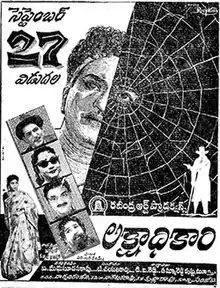Lakshadhikari
Lakshadhikari (transl. Lakhier)[lower-alpha 1] is a 1963 Indian Telugu-language thriller film written by Narla Chiranjeevi and directed by V. Madhusudhan Rao. It is the inaugural production of Tammareddy Krishna Murthy and D. Venkatapathi Reddy's company Ravindra Art Pictures. The film stars N. T. Rama Rao and Krishna Kumari, with V. Nagaiah, Gummadi, Relangi, Ramana Reddy, Mikkilineni, K. V. S. Sarma, Suryakantham, Girija and Rushyendramani in supporting roles. It was released on 27 September 1963, and became a commercial success.
| Lakshadhikari | |
|---|---|
 Theatrical release poster | |
| Directed by | V. Madhusudhan Rao |
| Produced by | Tammareddy Krishna Murthy D. Venkatapathi Reddy |
| Written by | Narla Chiranjeevi |
| Starring | N. T. Rama Rao Krishna Kumari |
| Music by | T. Chalapathi Rao |
| Cinematography | C. Nageswara Rao |
| Edited by | Akkineni Sanjeeva Rao |
Production company | Ravindra Art Pictures |
Release date |
|
Running time | 154 minutes[1] |
| Country | India |
| Language | Telugu |
Plot
Rangaiah is a millionaire, whose loyal and trusted manager is Seethaiah. Seethaiah's wife Lakshmi takes care of Rangaiah's motherless son. Rangaiah's brother-in-law, the greedy Sivam, frames Rangaiah for murder, has him sent to prison for 20 years, and kidnaps his son. But the boy is saved by a childless couple Pichaiah and Achamma, who found him unconscious on the river bed and raise him as Prasad. Later, Achamma gives birth to a daughter, Leela.
Seethaiah's daughter Padma falls in love with Prasad. Seethaiah offers Prasad a high-ranking position in his pharmaceutical company. Rangaiah is released upon completing his prison term. Prasad learns the truth about his parentage. Strange things happen, which Prasad suspects are centered around Seethaiah's house. With help from Padma and S. S. Rao (the servant Panakalu's son), he solves the mystery and exposes the real culprit for the wrong deeds.
Cast
- N. T. Rama Rao as Prasad
- Krishna Kumari as Padma
- V. Nagaiah as Rangaiah[3]
- Gummadi as Seethaiah
- Relangi as S. S. Rao[3]
- Ramana Reddy as Pichaiah[3]
- Mikkilineni as Panakalu[3]
- K. V. S. Sarma as Sivam[3]
- Suryakantham as Achamma[3]
- Girija as Leela
- Rushyendramani as Lakshmi[3]
Production
Development
After working as a production controller at Saradhi Studios for years, Tammareddy Krishna Murthy established his own production company Ravindra Art Pictures (named after the poet Rabindranath Tagore) with his friend D. Venkatapathi Reddy as partner. For the company's debut production, which would eventually become Lakshadhikari, Krishna Murthy signed V. Madhusudhan Rao to direct and Narla Chiranjeevi as writer.[3]
The original story was simply a "family drama", which did not fully satisfy Krishna Murthy. When Krishna Murthy met producer Parvathaneni Gangadhara Rao, the latter advised him to include an element of suspense in the story, and Krishna Murthy liked the idea. Heeding to Krishna Murthy's wishes, Narla Chiranjeevi rewrote the story to make it look more like a thriller. Cinematography was handled by C. Nageswara Rao, and the editing by Akkineni Sanjeeva Rao.[3]
Casting and filming
N. T. Rama Rao was cast as the male lead Prasad; the fact that he and Krishna Murthy bonded during the making of Palletooru (1952), which was Krishna Murthy's cinematic debut as production manager, helped him get Rama Rao's dates for Lakshadhikari. Krishna Murthy initially chose Nagabhushanam to play the character Seethaiah, but later replaced him with Gummadi as he felt he could "conceal villainy behind his soft demeanour and mislead the audience."[3]
One scene filmed at the swimming pool of the College of Engineering, Guindy had Padma (Krishna Kumari) in a swimsuit, but it was edited out by the Censor Board who declared that "the heroine should not wear a swim suit". The exterior portions of Chandamama Buildings in Vadapalani stood in for the college where Padma and Leela (Girija) study. The end of the song "Mabbulo Yemundi" required that Rama Rao and Krishna Kumari walk holding each other's hands on the seashore. As they were walking, a giant wave swept them away. Krishna Kumari did not know swimming and almost drowned, but Rama Rao held her hand tightly and saved her. Peketi Sivaram created the film's revolver sound effects.[3]
Soundtrack
The soundtrack was composed by T. Chalapathi Rao.[4]
| No. | Title | Lyrics | Singer(s) | Length |
|---|---|---|---|---|
| 1. | "Achammaku Nithyamu Seemantamayene" | Kosaraju Raghavaiah | K. Rani, Swarnalata, Vaidehi | 3:15 |
| 2. | "Oho Andhamaina Chinnadhana" | Kosaraju Raghavaiah | Madhavapeddi Satyam | 2:51 |
| 3. | "Yelago Yelago Yelago Unnadhi" | Aarudhra | P. Susheela | 3:32 |
| 4. | "Dachalante Dagadule Dhagudumootalu Sagavule" (female) | C. Narayana Reddy | P. Susheela | 3:12 |
| 5. | "Mabbulo Yemundi Naa Manasulo Yemundi" | C. Narayana Reddy | Ghantasala | 3:46 |
| 6. | "Addhala Meda Undhi Andhala Bhama Undhi" | Kosaraju | Ghantasala, Jamuna Rani, Madhavapeddi Satyam | 3:55 |
| 7. | "Dachalante Dagadule Dhagudumootalu Sagavule" (duet) | C. Narayana Reddy | P. Susheela, Ghantasala |
Release and reception
Lakshadhikari was released on 27 September 1963.[5] The film performed well at the box office, and became a trendsetter for more suspense-filled films in Telugu.[3]
References
- "Lakshadhikari". Complete Index to World Film. Retrieved 18 November 2018.
- Hankin, Nigel (2003). Hanklyn-Janklin. India Research Press. p. 288. ISBN 978-81-87943-04-4.
- Narasimham, M. L. (15 December 2016). "Lakshadhikari (1963)". The Hindu. Archived from the original on 21 December 2016. Retrieved 17 November 2018.
- Lakshadhikari (songbook) (in Telugu). Ravindra Art Pictures. 1963.
- "Lakshadikari". Indiancine.ma. Retrieved 18 November 2018.